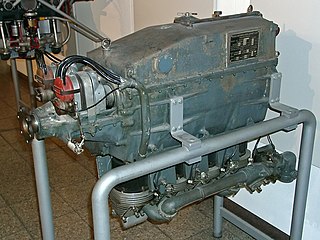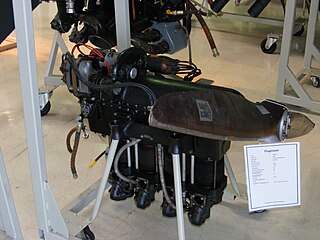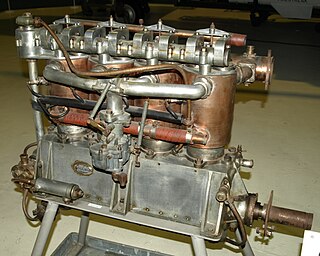Related Research Articles

The Centaurus was the final development of the Bristol Engine Company's series of sleeve valve radial aircraft engines. The Centaurus is an 18-cylinder, two-row design that eventually delivered over 3,000 hp (2,200 kW). The engine was introduced into service late in the Second World War and was one of the most powerful aircraft piston engines to see service. The Royal Navy Historic Flight operates a Hawker Sea Fury, powered by a Bristol Centaurus engine.

The de Havilland Gipsy Major or Gipsy IIIA is a four-cylinder, air-cooled, inverted inline engine used in a variety of light aircraft produced in the 1930s, including the famous Tiger Moth biplane. Many Gipsy Major engines still power vintage aircraft types worldwide today.
The Cirrus and Hermes or Cirrus-Hermes are a series of British aero engines manufactured, under various changes of ownership, from the 1920s until the 1950s. The engines were all air-cooled, four-cylinder inline types, with earlier ones upright and later designs inverted.

The ERCO IL-116 was an American inline aircraft engine designed and built in the late 1930s. The type was not placed into series production due to competition from cheaper engines.

The de Havilland Gipsy is a British air-cooled four-cylinder in-line aircraft engine designed by Frank Halford in 1927 to replace the ADC Cirrus in the de Havilland DH.60 Moth light biplane. Initially developed as an upright 5 litre capacity engine, later versions were designed to run inverted with increased capacity and power.

The Walter Mikron is a four-cylinder, air-cooled, inverted straight engine for aircraft.

The Argus As 8 was a four-cylinder, air-cooled, inverted inline aircraft engine produced in Germany by Argus Motoren in the 1930s.

The Walter Minor is a family of four- and six-cylinder inverted inline air-cooled engines, developed under auspices of ing. Šimůnek and used on light aircraft. First produced in 1929, the Minor engines' family has an advanced design for the period and sports steel cylinders, aluminum heads and overhead valves, with identical bore and stroke of 105 mm (4.1 in) and 115 mm (4.5 in), respectively. Typical power ratings varied from 105 hp to 160 hp.

The Blackburn Cirrus Minor is a British four-cylinder, inverted, in-line air-cooled aero-engine that was designed and built by the Cirrus Engine Section of Blackburn Aircraft Limited in the late 1930s.

The Blackburn Cirrus Major is a British, inline-four aircraft engine that was developed in the late 1930s.

The Hirth HM 60 was a four-cylinder inverted air-cooled inline aircraft engine designed in 1923 and first sold in 1924. The engine was of very high quality, and its sales success contributed to Hirth's rapid pre-war expansion. It was a popular engine for light aircraft delivering 80 hp (60 kW) at 2,300 rpm. Later Hirth engines built upon the HM 60's success and provided greater power with many of the same design features.

The ADC Cirrus is a series of British aero engines manufactured using surplus Renault parts by the Aircraft Disposal Company (ADC) in the 1920s.

The de Havilland Gipsy Minor or Gipsy Junior was a British four-cylinder, air-cooled, inline engine used primarily in the de Havilland Moth Minor monoplane, both products being developed in the late 1930s.

The Napier Javelin was a British six-cylinder inline air-cooled engine designed by Frank Halford and built by D. Napier & Son. First flown in March 1934 in the prototype of the Percival Mew Gull racing aircraft, the engine was also used in the Spartan Arrow biplane and the Percival Gull.

The Blackburn Cirrus Bombardier was a British four-cylinder inline aircraft engine, developed and built by the Blackburn Aircraft company in the mid-1950s. The engine featured fuel injection.

The ADC Airdisco is a British V-8 aero engine that first ran in 1925.
The ADC Nimbus was a British inline aero engine that first ran in 1926. The Nimbus was developed from the Siddeley Puma aero engine by Frank Halford of the Aircraft Disposal Company, the goal was to develop the Puma to produce its intended power output which Halford eventually achieved. The Nimbus was further developed into an air-cooled version known as the ADC Airsix which did not enter production and was not flown.
The de Havilland Ghost was a British V-8 aero engine that first ran in 1928.

The Green C.4 was a British four-cylinder, water-cooled aero engine that first ran in 1908, it was designed by Gustavus Green and built by the Green Engine Co and Aster Engineering. The engine was one of two Green designs to win a government prize.
The Train 2T, 4T and 6T were low power piston engines for light aircraft, produced in France. They were inverted, air-cooled in-line engines with the same bore and stroke, differing chiefly in the number of cylinders.
References
Notes
Bibliography
- Lumsden, Alec. British Piston Engines and their Aircraft. Marlborough, Wiltshire: Airlife Publishing, 2003. ISBN 1-85310-294-6.